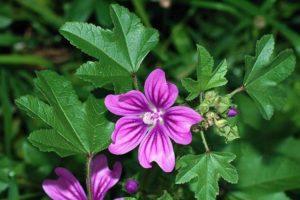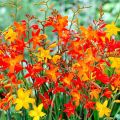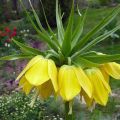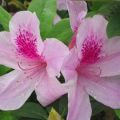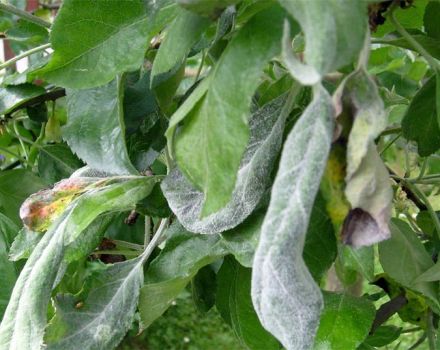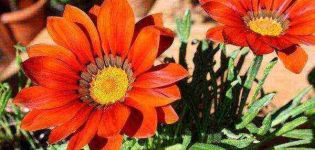Description and varieties of crocosmia, planting and care in the open field
Crocosmia is a bulbous plant widely grown in the CIS countries by experienced gardeners and beginners. The culture is unpretentious to the soil, excellent for cultivation by summer residents. With its help, they decorate the garden, create marvelous flower combinations. You should first familiarize yourself with the procedure for planting and caring for crocosmia in the open field.
Description and features of crocosmia
Crocosmia belongs to the iris family, its dried flowers smell of saffron. From Greek, the name is translated as "weather vane". Paniculate inflorescences have a spreading shape, they are white, orange and yellow, with a diameter of 5 cm. The fruit contains a polyspermous round-shaped box. In the wild, crocosmia grows in South Africa. In European countries, it has been cultivated since the 19th century.
The plant grows from 0.4 to 1.5 meters in height. Branching stems, on them leaf plates of a xiphoid or linear shape are localized. The culture resembles gladiolus, it is grown in the same way.With the help of crocosmia, open flower beds are widely decorated, flowers are cut to create bouquets. They can be stored torn for about 15 days..
Growing
Crocosmia does not imply any particular difficulties in growing. The plant requires support, well preparation and suitable soil. Tubers are pretreated to stimulate their successful rooting in a new place.
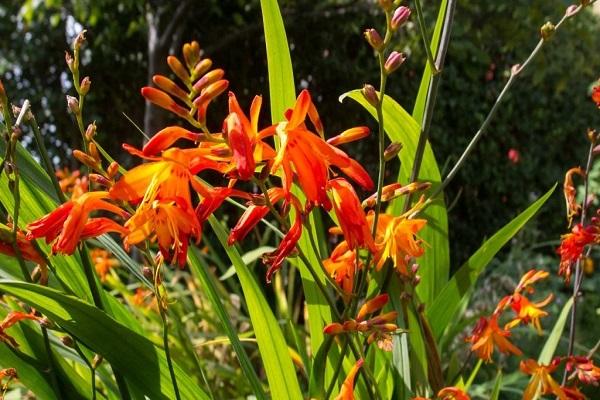
Landing place
Crocosmia is grown preferably on fertile lands with a lot of humus. The location of groundwater close to the soil surface is unacceptable. If the plant cannot be transferred to a dry place, drainage work and the laying of underground currents are first carried out. It is necessary to plant the plant in well-lit plots, where there are no tall trees, perennial flowers or bushes. The place must be protected from the wind.
When to plant crocosmia
Experienced gardeners recommend planting crocosmia in a permanent place at the end of April or early May. The earth should warm up to 10 degrees Celsius.
Preparation of planting material
Corms are treated in a weak solution of potassium permanganate before planting. You can also dip them for 30 minutes in a growth stimulant like Kornevin, Epin.
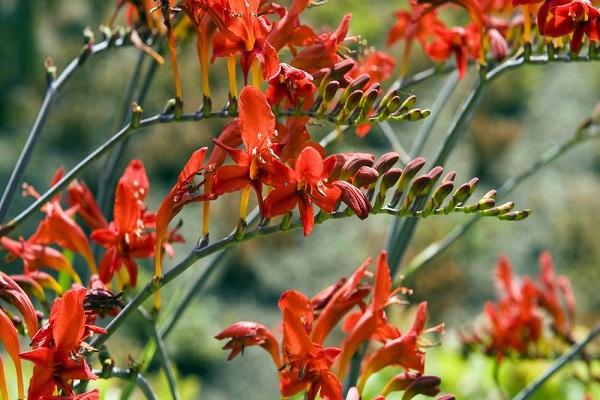
Soil preparation
Soil preparation is done in autumn.The land is plowed, 2 buckets of humus, 40 g of superphosphate, 100 g of slaked lime and 20 g of potassium chloride are added for each square meter. In the spring, before planting, nitrogen-containing substances are added to the soil in a ratio of 1 sq. M. 30 g of composition.
Landing scheme
Each bush should be at a distance of 10 cm from each other.The optimal hole depth is 25 cm.
Care
It is not difficult to care for crocosmia, it is only necessary to water it in time, cut it off, feed it, loosen the ground.It is advisable to grow the crop in the South or in the middle latitudes. Since the plant is southern, it is unlikely to take root in the North..
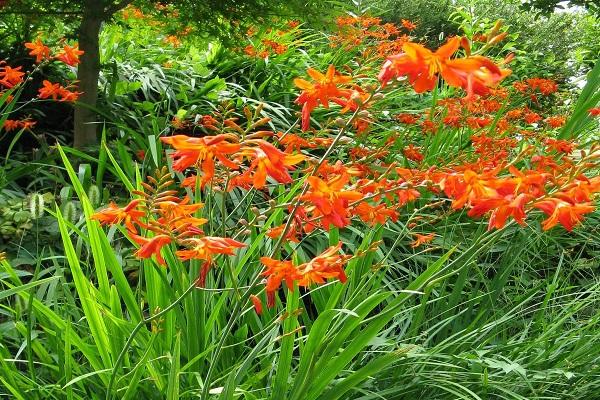
Watering
Crocosmia is watered once a week with settled water. Overflows should not be allowed, since the bulbs can rot. You can spray the leaves in the heat, after 4 pm with plain water from a spray bottle.
Loosening and weeding
After rains and irrigation, the soil is loosened, weeds are removed. The procedure contributes to the saturation of the soil with oxygen, the penetration of moisture to the rhizome. Weeds interfere with the full growth of crocosmia, absorb nutrients from the ground.
Garter
Most crocosmia varieties grow tall and require support. As such a structure, pegs are taken, to which flower stalks are tied. If the rule is ignored, the stems can break off under the weight of the inflorescences. Nutrients will be better delivered to the rhizome through the garter.
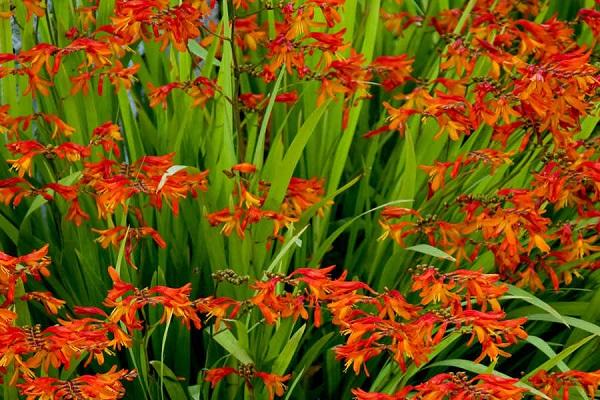
Top dressing of crocosmia
When the leaves appear, they make the first replenishment of the soil with the help of mineral fertilizers. They are brought into the beds with bushes in 1 bucket. You can water the culture with infusion of cow dung, poultry droppings. Fertilize it from 3 times a month. By the fall, crocosmia is fed with potassium. The event will help strengthen the corms, the plant will overwinter safely.
Pruning
After flowering, crocosmia peduncles are cut off with a disinfected pruner. The procedure is required so that she does not waste energy on them, but gives her power to feed the bulb, the education of children. You can leave the first 2-3 flower stalks on the bushes to get seeds from them. They are dried, laid out in cloth bags, stored in a dry place.
Pests and diseases
Bears and thrips are capable of attacking crocosmia. The first insects gnaw the tubers, they begin to hurt, the leaves wither, and rotting occurs. Among the diseases are fusarium, jaundice, fungi. Resistance to them is average.
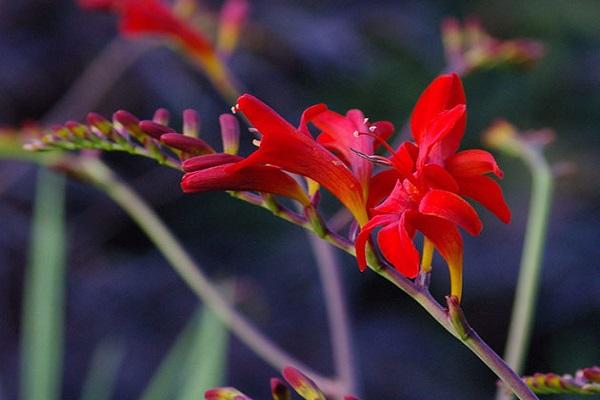
Preparing for winter
It is necessary to shelter the culture for the winter in regions where the air temperature drops from -20. In autumn, the bulbs are removed from the ground, around the beginning of October. They need to be dried, placed in a cool, well-ventilated room with an air temperature of +10.
When it comes to areas with warm winters, you don't need to dig up the flower. It is sprinkled with a mulching layer of spruce branches, wood chips, dried leaves. In the South, the site is covered with mulch with a layer of 20 cm. Clay film is placed on top. When spring comes, the shelter is removed, old leaves are cut to the ground.
Reproduction
Crocosmia is bred with seeds, children. Each of the methods involves a separate technique, described below. The first method is more laborious and time consuming. Reproduction by seedlings is popular.
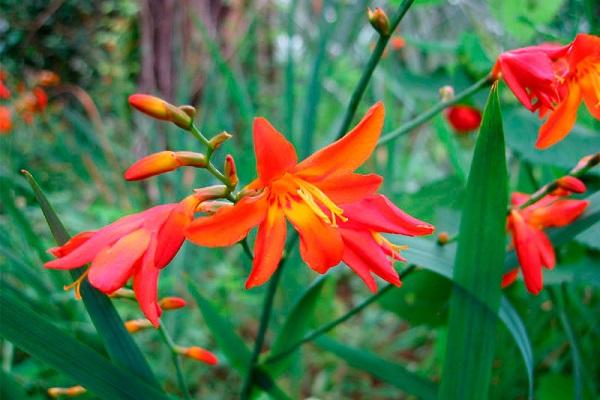
Seeds
When sowing seeds into the soil, crocosmia shoots may not appear. The procedure is carried out in late February or early March. Before sowing, the seeds are poured with water for 1 day, changing it every 6 hours. Sow them into a soil mixture of peat, sand, sod land and humus. The container is covered with cling film, moved to a lighted place.
Children
Up to 6 babies are formed on the tubers annually. Every 2 years, in March, you can dig up an adult bush, separate the seedlings from it, planting them in separate containers. In May, seedlings must be planted in a sunny place in holes up to 10 cm deep.This method helps not only to propagate the culture, but also to rejuvenate old bushes.
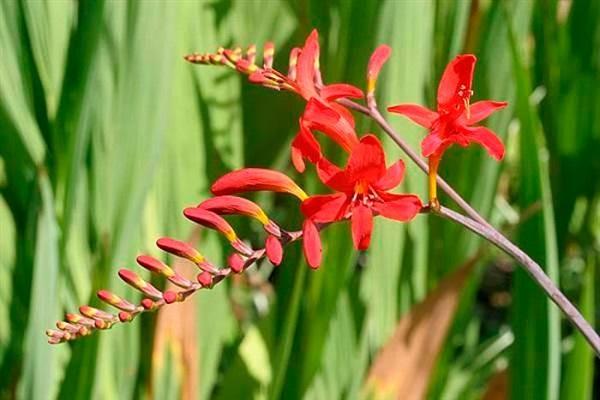
Popular types and varieties of crocosmia
There are more than 50 varieties of crocosmia, but in the countries of the former USSR, only 11 are cultivated. Their detailed description is given below.
Golden
Crocosmia is distinguished by linear leaves, small inflorescences of golden, red or orange color. Bushes bloom in September.
Massonorum
The plant is famous for its rich green xiphoid leaves. The flowers are fiery orange. Bushes grow up to 60 cm tall, densely covered with inflorescences. Pollen falls in mid-July. The variety has the highest resistance to frost.

Potts
Crocosmia grows well in swampy areas, it is widely planted in darkened areas. The leaves are narrow, emerald. The shade of the flowers is orange, they are small in size.
Lucifer
The bush reaches 1.5 meters in height. The flowers are painted in pastel colors or intensely fiery.
McKenzie
The plant is undersized, reaches 60 cm in height. Inflorescences are orange-brown, pointed towards the ends.
Red King
The height of the crocosmia is about 80 cm. The inflorescences are deep orange in color, with a speck in the middle.
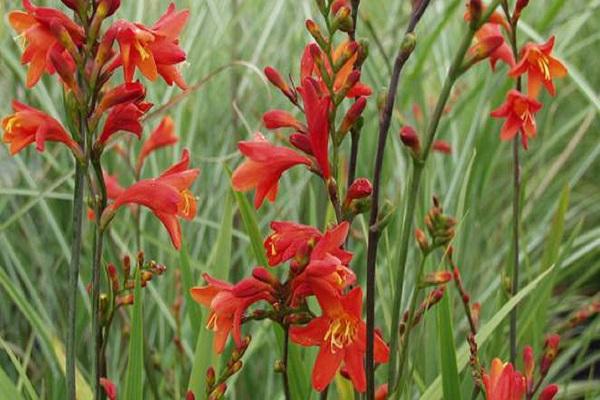
Tangerine queen
The culture grows up to 1.2 meters high, the shade of the stems and leaves is rich green. The flowers are orange, large in size.
Citronella
The height of the bushes reaches about 1 meter, the leaves and stem of a pale green color. Inflorescences are bright yellow, flexible.
Star of the East
Crocosmia grows up to 1 meter in height, the stems are strong, the leaves are rich green. Peduncles of apricot shade, their diameter is 10 cm. This is the longest flowering variety, pollen stops with the arrival of the first frosts.
George Davidson
The bush has an average height of about 70 cm. A rosette of dark green leaves and amber panicles are its distinguishing features. The variety is often grown for the purpose of further cutting.
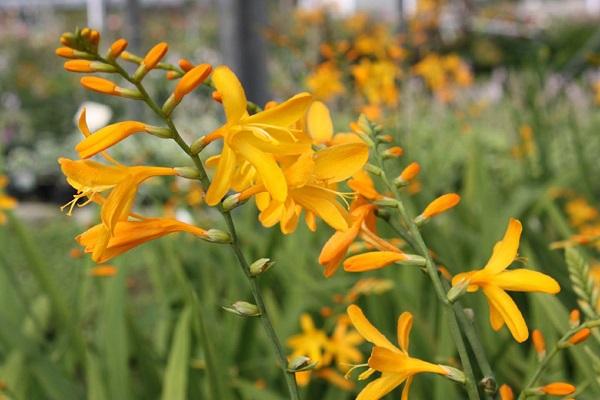
Paniculata
This is one of the most common varieties, the bushes grow up to 150 cm tall. Stems and leaves are deep green, narrow. Pollen falls in June, the shade of inflorescences is orange-brown.
Possible difficulties
Crocosmia sometimes suffers from fungal infections when grown in flooded lands. Transplanting and fungicide treatment will help to destroy rot. Flowers can also succumb to the invasion of Fusarium. The bulbs take on a dark shade, they are soft, covered with stripes. It is difficult to cure the disease, it is better to isolate the bush and destroy the affected parts.
Crocosmia can also get sick with jaundice, in which the bulbs turn yellow and become dense. Many shoots are formed on them, with thin and yellowish foliage. In the early phase of pathology, you can completely get rid of it by heating the bulb to +45 degrees.
They are fighting with Medvetox, Grizzly, Thunder drugs. It is also recommended to set repelling traps to help isolate the area from harmful beetles. Thrips are removed by spraying the bushes with chemicals, they are bred in the specified proportions.
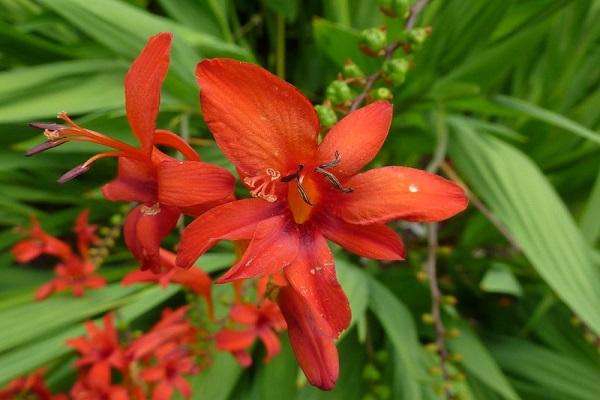
Use in landscape design
Crocosmia will be a chic decoration for any garden. Blooming bushes create colorful cascades on lawns, near ponds, pools, fountains.
Tall varieties decorate the dilapidated walls of buildings or gazebos. Tritonia is good in monoculture, or among mixed flower beds. The culture can be planted in flower beds, flower beds, rockeries.

